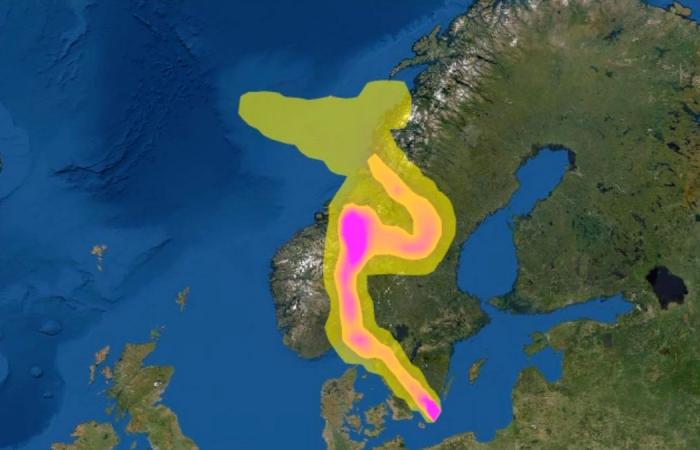96 percent of the gas in the two pipelines was the powerful greenhouse gas methane. It is the gas in the white bubbles you see rising to the sea surface.
On Wednesday morning, senior climate scientist at the Norwegian Institute for Air Research, Stephen Matthew Platt, sat down to calculate how big the emissions were. He calculated based on measurements from the Birkenes observatory in Agder
The researcher tells NRK that he was surprised when he calculated the numbers.
– When I started counting on this on Wednesday morning, I expected not to see anything. It is very often that you hear about large emissions, but when you look at the data, you don’t see any signs of it. But here there was a clear increase, says Platt.
The graph clearly shows how the methane concentration in the air, compared to normal, goes up after the explosions in the Baltic Sea.
Startling numbers
With help from European ICOS, Platt concluded that the leaks led to the release of around 40,000 tonnes of methane.
– The preliminary calculations we have made show that the emissions correspond to twice as much as the annual methane emissions from the oil and gas industry in Norway, says Platt.
The graph showing the emissions of CO₂ then also goes straight into the air on Monday, when the emissions occurred.
The emissions correspond to an increase in the concentration of methane in the atmosphere of around 20 per cent.
– These are record high levels, we have never seen anything like this before in Norway and Sweden, says Platt.
No immediate danger
Stephen Matthew Platt, who is a senior climate researcher at the Norwegian Institute for Air Research (Nilu).
Photo: Nilu
The gas cloud moves with the wind and spreads over time. Platt and his colleagues are following it closely and updating the calculations.
– The latest indication is that gas is moving north and can be seen over Svalbard in a couple of days, says Platt.
The researcher nevertheless emphasizes that the high concentration of methane does not pose any acute danger to people.
– This is not dangerous for humans. It is not a flammable gas in these quantities. It is the climate effect we are talking about, he says.
The gas leak after the explosion was so strong on Monday that it was visible from space.
Photo: Planet Labs PBC
20 times more powerful than CO₂
As a greenhouse gas, methane is approximately 32 times as powerful as CO₂. But the emissions are smaller and the lifespan in the atmosphere shorter.
– If you calculate the effect over 100 years, you like to say that methane is 20 times more powerful than CO₂, says Bjørn Samset. He is a climate researcher at the climate foundation Cicero.
Because far more CO₂ is emitted, it is nevertheless the biggest threat to the climate.
But internationally, there has been a lot of attention to methane in the past year.
This is because reducing methane emissions is the fastest way to slow global warming.
– Since methane is so potent, it is important to reduce methane emissions in the short term so that the earth does not get warmer as fast as it does, says Samset.
Photo taken by the Swedish Coast Guard shows how the gas comes up from the sea after one of the explosions.
Photo: Swedish Coast Guard / AP
Only a small fraction of emissions
Although the emissions from the pipelines have increased the concentration over Scandinavia, Samset believes that they mean little in a climate context.
He points out that from energy production and from agriculture we release close to 1 million tonnes of methane per day.
– It is clear that 40,000 tonnes is a lot and it is an unnecessary emission that comes on top of all the others. But in relation to all our activities, it will not be a very large addition, says Bjørn Samset.
Tags: Record high methane levels Scandinavia explosions gas pipelines NRK Urix Foreign news documentaries
-






